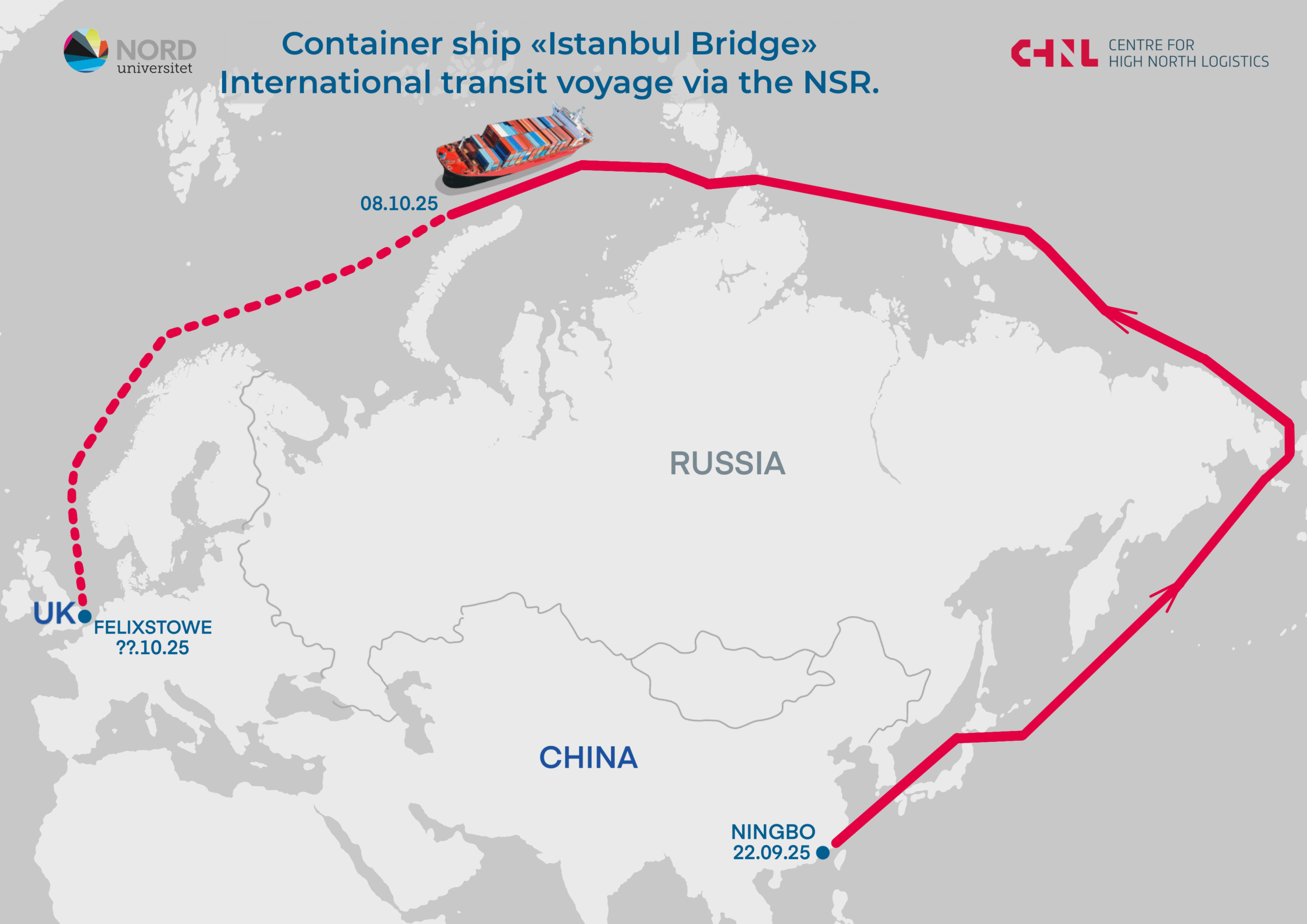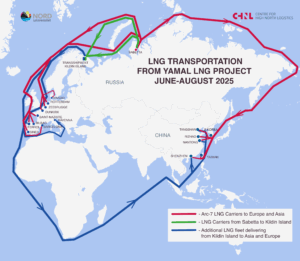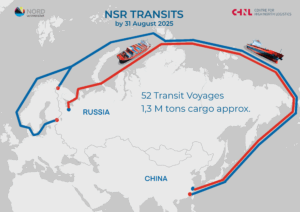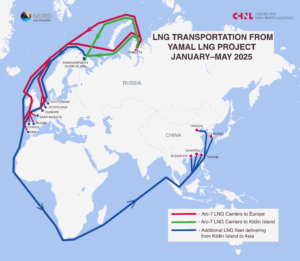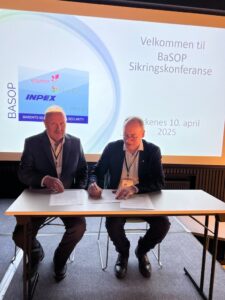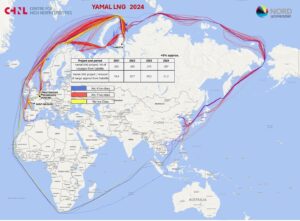Update as of October 14, 2025
The vessel arrived at the Port of Felixstowe on October 13 at 19:40. The total duration of the voyage was 20 days and 22.5 hours. The actual distance traveled, based on the vessel’s track, was 7,850 nautical miles, with an average speed of 15.62 knots.
On the final leg of the journey – from Cape Zhelania to Felixstowe the vessel reduced its speed from 16.7 knots (on the NSR) to 13.5 knots. This segment covered 2,223 nautical miles. Had the vessel maintained its NSR speed, it could have arrived 1.3 days earlier, completing the route in 19.6 days.
The previously made calculations and comparison with the southern route remain unchanged. We add one clarification: some publications estimate the southern route between the same ports to take 40–50 days, covering a distance of 11,000 miles. However, our time estimate is only 27 days, excluding potential port calls. The difference may stem from the fact that vessels typically travel non-stop along the NSR, while port calls are more likely along the Suez Canal route, increasing total transit time. Our comparison is based solely on distance and speed.
ETA Update – 13.10.2025
As of 08:00 UTC on October 13, the vessel has approximately 140 miles remaining to reach the port of Felixstowe. According to the ship’s report transmitted at 02:10 on October 13, the estimated time of arrival is 17:00 on October 13, which corresponds to the remaining distance and the current speed of 16 knots.
Text below last updated as of 10:00 UTC, October 8, 2025
In recent years, international transit shipping via the NSR has virtually ceased. The last recorded voyages connecting non-Russian ports in Europe and Asia through the NSR occurred in 2021. Since then, transit along the route has primarily taken place between Russian ports in the western and eastern parts of the country, as well as between Russia and Asian countries, mainly China.
The container ship Istanbul Bridge may become the first full-scale international transit vessel to pass through the NSR after a long hiatus. The vessel is en route from China to the United Kingdom. As of October 8, 2025, it has already completed the transit segment of its NSR route and continues its journey toward its destination port – Felixstowe.
Previous transits along the NSR.
The Istanbul Bridge was built in 2000. It has ice class Ice-1, a length of 294 meters, and a container capacity of 4,843 TEU. In 2024, it had already transited the NSR under the name Flying Fish 1, becoming the largest container ship among transit voyages that year. Its deadweight is 66,781 tons, and the cargo volume during the 2024 transit voyage was approximately 41,000 tons, including 664 twenty-foot and 1,727 forty-foot containers. These figures were reported in press releases by Atom Media. During that voyage, the vessel departed from Saint Petersburg on August 31 and arrived in Shanghai on September 28, 2024.
Transits in 2025
This article covers 2 transit voyages of Istanbul Bridge in 2025. All data is based on AIS tracking of the vessel’s movements. The focus is on the technical aspects of the transit passage: distance traveled, time en route, average speed, ice conditions, and the presence of icebreaker escort. These parameters will also be compared with similar characteristics of the route via the Suez Canal. All times are given in UTC, as displayed in the AIS system.
The first transit voyage this year followed the route Saint Petersburg (Russia) – Qingdao (China) from August 20 to September 11. According to our calculations, the total distance of the first voyage was 8,717 nautical miles, with an average speed of 15.82 knots and a transit time of approximately 22.9 days. On the NSR segment, the vessel maintained an average speed of 15.77 knots, completing the passage in 5.9 days. The distance between Cape Zhelaniya in the west and Cape Dezhnev in the east was 2,233 miles.
Map 1. First transit voyage from St. Petersburg (Russia) – Qingdao (China) from August 20 to September 11
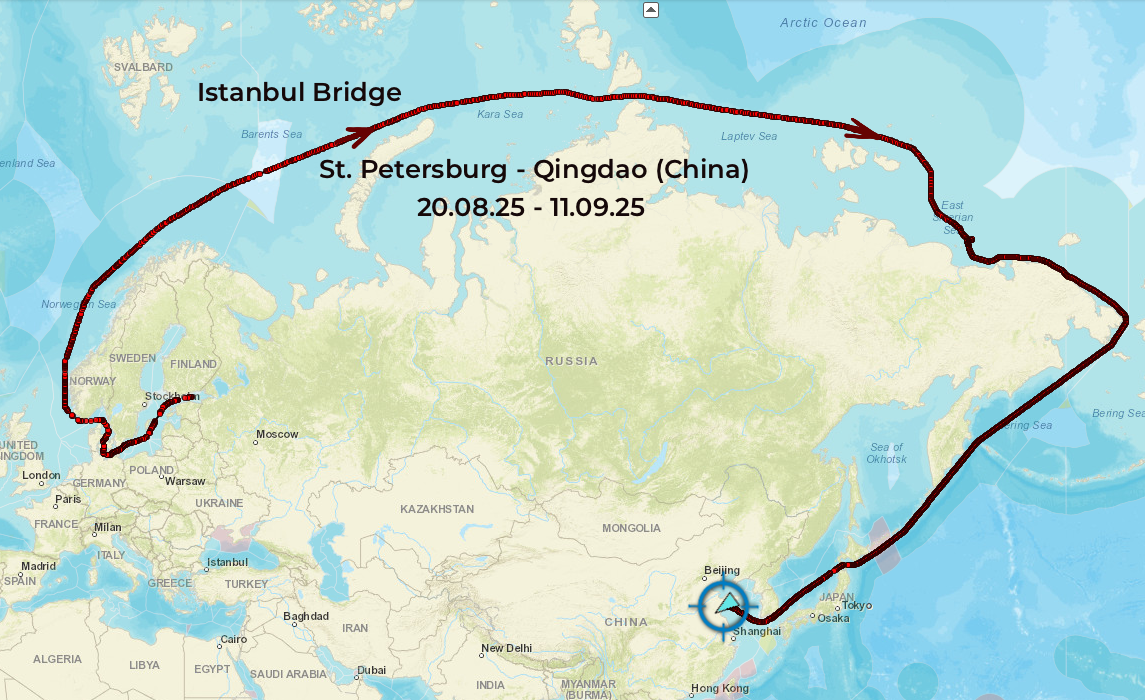
After transiting the NSR from Saint Petersburg, the vessel arrived at its first Chinese port, Qingdao, on September 11 at 23:00. It then called at the container terminal in Dalian on September 16, followed by Shanghai on September 19, Putian on September 20, and Ningbo on the morning of September 22.
Map 2 Movements of the vessel between Chinese ports
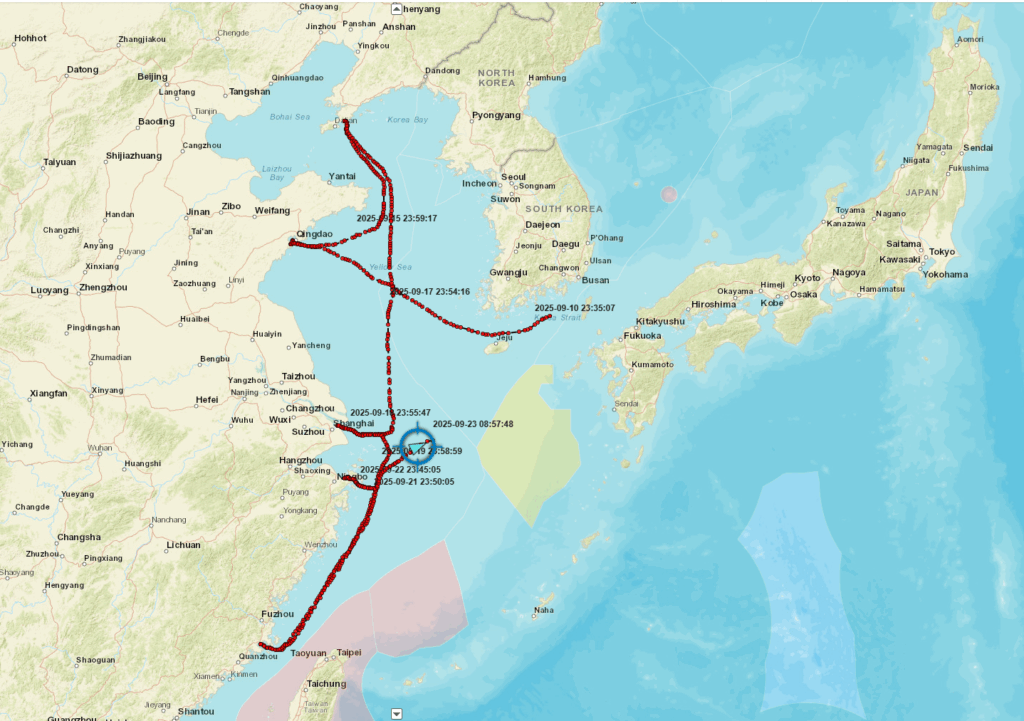
Second transit in 2025
The vessel departed Ningbo for its 2nd NSR transit voyage on September 22 at 21:05. During the first leg of the voyage from Ningbo to the NSR eastern entry point, the vessel maintained an average speed of 16.63 knots. The distance to point near Cape Dezhnev was 3,528 miles. The vessel entered the NSR waters at approximately 17:15 on October 1, 2025. At that time, ice conditions in the eastern part of the NSR had improved.
Map 3. Ice Conditions in the East Siberian Sea during the periods of September 20–22, 2025 and October 2–4, 2025
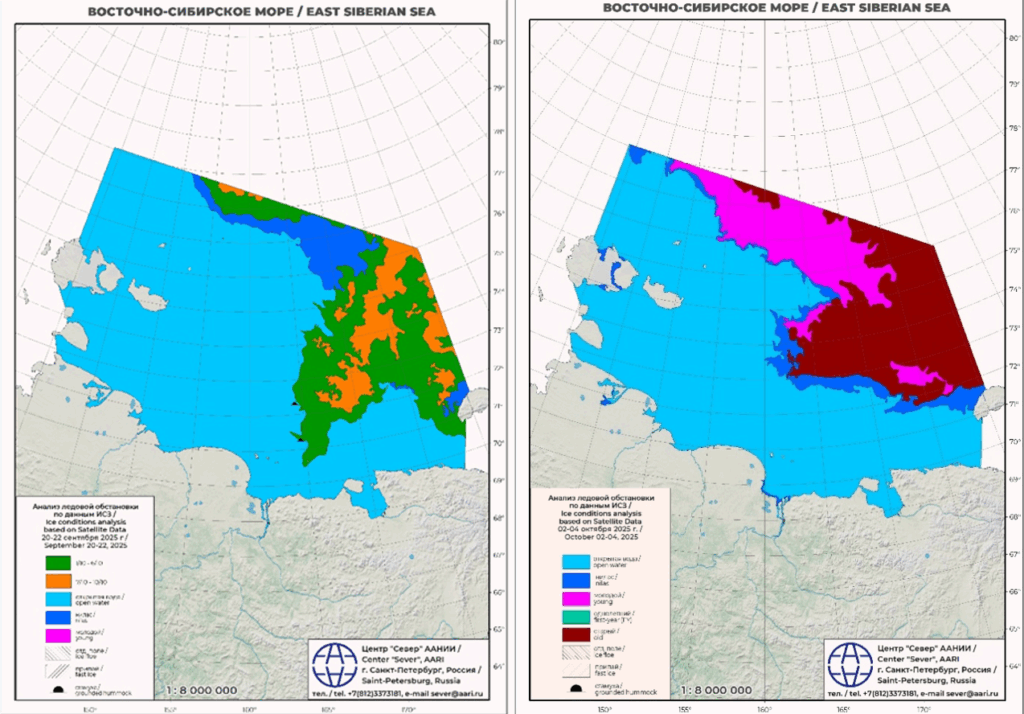
Ice charts of the East Siberian Sea show that between October 2 and 4, there was open water and a sufficiently wide clear passage between Wrangel Island and the Pevek port area, as shown on the map to the right. In late September, this region had ice accumulation, and transiting vessels experienced difficulties, as seen on the left-hand map. Thus, Istanbul Bridge passed the eastern NSR segment at high speed through open water.
During the vessel’s passage through the East Siberian Sea, the nuclear icebreaker 50 Let Pobedy was present. According to vessel tracking data, no physical icebreaker escort was provided – the container ship sailed independently. A second nuclear icebreaker, Sibir, operating in the area, was anchored near the shore north of Pevek port.
Map 4. Icebreaker positions during the vessel’s passage through the East Siberian Sea
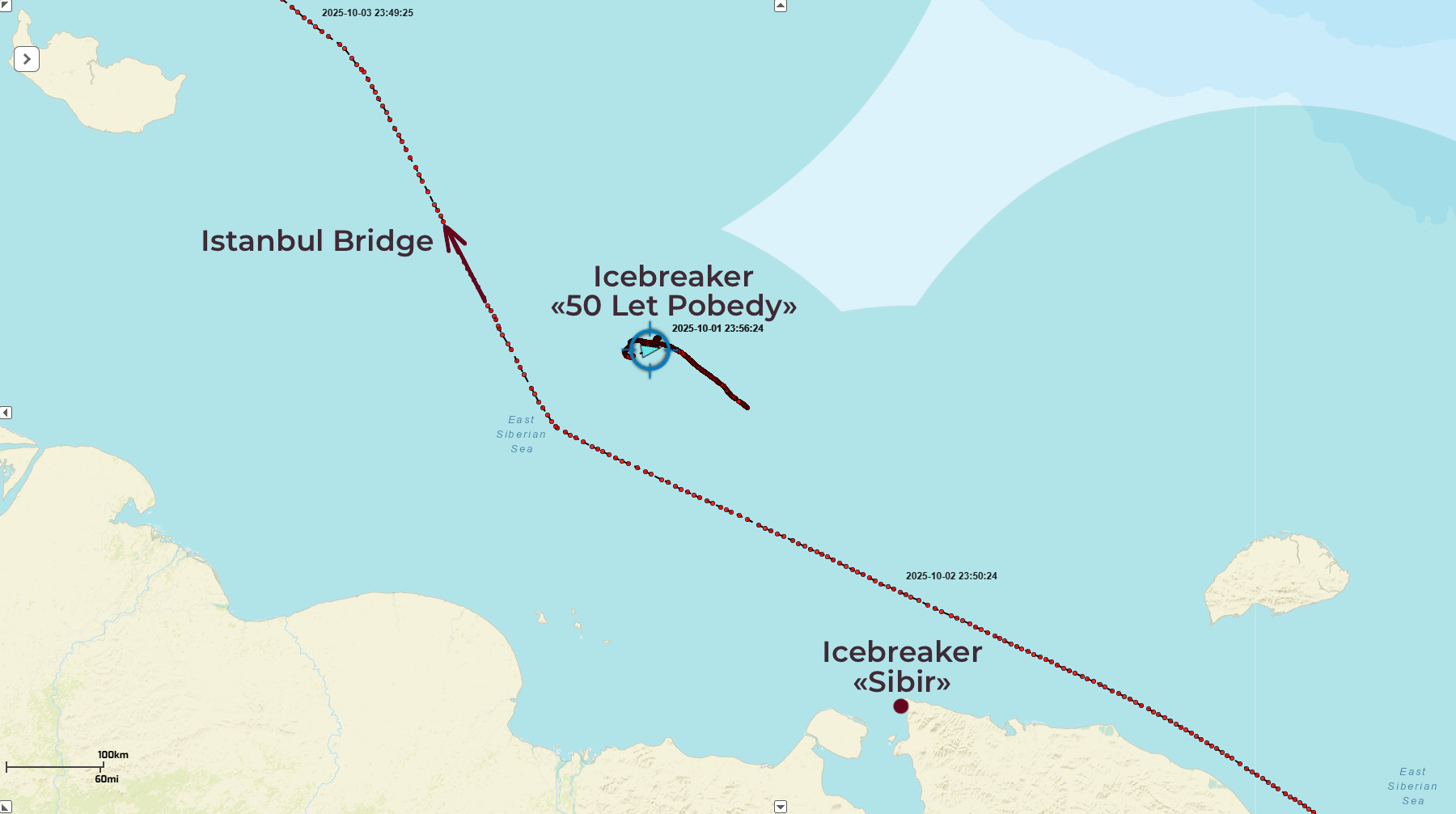
The NSR segment from Cape Dezhnev in the east to Cape Zhelaniya in the west was completed in 5.25 days, covering 2,106 miles at an average speed of 16.71 knots. Since the end of October 6, the vessel has been sailing southwest in the Barents Sea. After exiting the NSR waters, she reduced its speed to approximately 10.6 knots. As of the article’s publication on October 8 at 10:00 UTC, the vessel had traveled 360 miles in 34 hours.
Arrival estimates for the destination port.
According to the vessel’s reports, the expected time of arrival (ETA) at Felixstowe port is October 11 at 21:00. Based on our calculations, to arrive by this time, the vessel must travel approximately 1,818 more miles in 83 hours, requiring a speed of 21.9 knots which is unlikely. At the current speed of 10.6 knots, the vessel would need about 172 hours or 7.1 days. If it maintains the same speed as on the NSR – 16.7 knots – it would arrive in approximately 109 hours or 4.5 days, around 23:00 on October 12. All these calculations are estimates, as the vessel’s future speed and route are unknown. It is evident that the vessel is unlikely to reach Felixstowe by the evening of October 11. Thus, the minimum estimated transit time from Ningbo to Felixstowe via the NSR for this trip could be around 20 days. The total route length is approximately 7,834 miles.
For comparison, consider the vessel’s voyage from Ningbo to Saint Petersburg via the southern route, which took place from April 13 to May 16, 2025. Measurements were taken up to the vessel’s traverse past the port of Felixstowe. The total calculated distance, based on the vessel’s AIS track, was 11,167 nautical miles. Excluding port calls, the manually measured sailing distance was approximately 10,540 nautical miles. After departing Ningbo on April 13, the vessel made three port calls: Guangzhou (China) on April 16 for one day, Port Klang (Malaysia) on April 20 for one day, and Aden (Yemen) on May 1, also for one day. The estimated transit time, excluding port stays and assuming an average speed of 16 knots, would be approximately 27 days.
Map 5. Example of a Southern route passage: Part of the voyage from Ningbo to St. Petersburg, April 13 – May 16, 2025

Therefore, comparing the Suez Canal route (estimated 27 days) with the NSR route (approximately 20 days) shows a time reduction of 7 days or 26%. The difference in distance is 2,706 miles: 10,540 miles via the Suez Canal versus 7,834 miles via the NSR, also about 26%.
Conclusion
A voyage between Ningbo (China) and Felixstowe (UK) via the NSR, under favorable ice conditions, could theoretically be 7 days faster and 2,706 miles shorter. The question remains how many voyages a single vessel of Ice-1 ice class can complete in one season. It is important to note that the open water navigation season on the NSR remains relatively short and not always predictable in terms of timing.
This article will be updated after the vessel arrives at its destination port.
